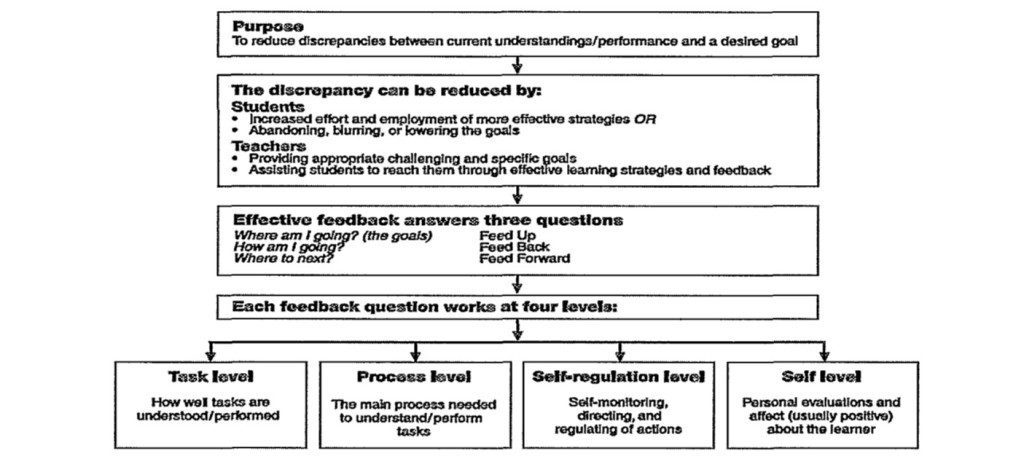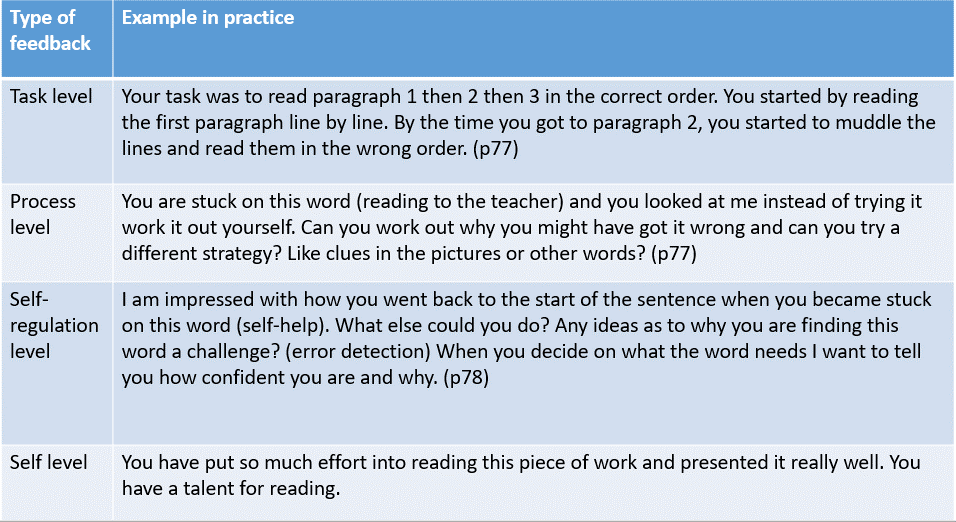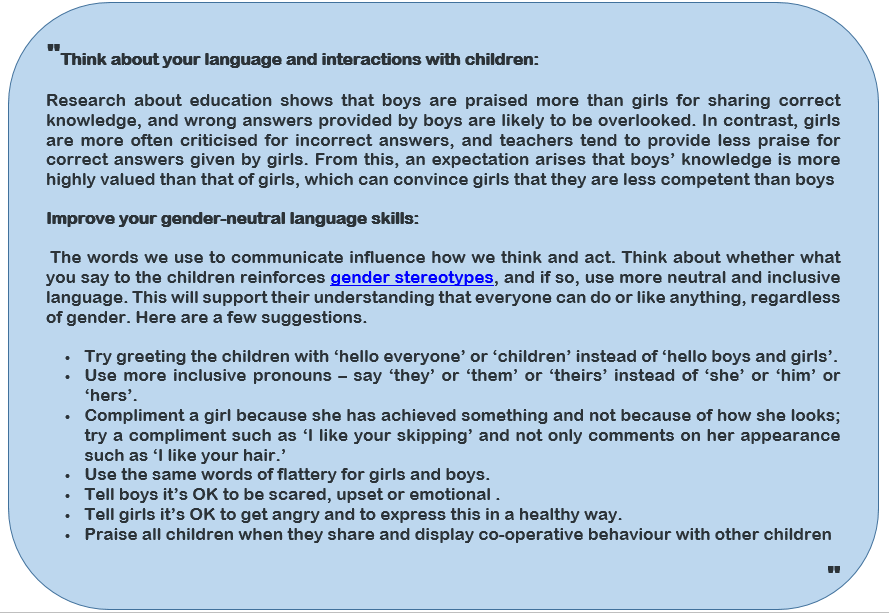If you have any accessibility requirements or would like to request the course content in a different format, please contact amy.johnson@educationscotland.gov.scot and hannah.brown@educationscotland.gov.scot
In this module we will explore how:
- Our interactions with the learner are a key aspect of the learning environment.
- The assumptions we unwittingly make about gender can influence the way we interact with, talk to and provide feedback to learners, leading to differences in the type of feedback received.
- Individual interaction and feedback can have either a positive or a negative effect on a child’s learning.
- The type of feedback and how feedback is delivered is closely linked to the development of self-confidence.
The module will reflect on how careful planning of interaction and feedback can help develop confidence by:
- How we talk to individuals – exploring 1:1 feedback and checking for patterns by gender
- Being aware of the ways in which we might unconsciously differ in the way we talk to, and provide feedback to, learners of different genders.
- Careful planning and design of activities, tasks, questions and deployment of feedback.
- Considering the type of feedback, and providing the reason for giving feedback.
Note that the term ‘feedback’ here, is used to cover all forms of individual interaction within a learning environment. This includes formal feedback about a piece of work, informal comment, and the ongoing interactions that are central and key to successful play pedagogy.
- Patterns in how we talk to individuals can be observed when the type of feedback is examined by gender. Dweck et al. (1978) suggest that girls tend to receive less negative feedback in general, but the majority of this feedback tends to focus on the quality of their work at a ‘task level’ (described below).
- Boys tend to receive more negative feedback but it tends to be focused on aspects unrelated to their work (e.g. behaviour and therefore relating to ‘self’).
- Most of the positive feedback boys receive is work focused whereas for girls the positive feedback can be based on non-intellectual aspects of their work (e.g. neatness, effort, behaviour). Often for boys, the feedback they receive either does not affect their self-efficacy or increases it. Often for girls, the type of feedback they receive can decrease their self-efficacy and lead them to believe ability is innate and can’t be changed (Dweck, 1978).
- A factor impacting and determining how well pupils receive and understand feedback, motivate themselves and persevere in the face of difficulty, is self-efficacy. There are gender differences in self-efficacy with girls tending to have lower self-efficacy even when their actual performance does not differ from that of boys (Fredericks & Eccles, 2002; Herbert & Stipek, 2005; OECD, 2015).
- Feedback can encompass comments, clarification, criticism, confirmation, content development, constructive reflection, correction, cons and pros, commentary and criterion (Hattie and Clarke, 2019). Click here for an expansion of these terms.
- According to Hattie and Timperley (2007) feedback can be given at task level, process level, self-regulation level and self-level (Self-level is the least effective for deep processing and mastery of tasks and process/self-regulation level has the most impact). Below is a diagram that exemplifies this followed by some examples of what these types of feedback would look like in practice. You may recognise aspects of self-regulatory feedback from Module 1 and Austin’s Butterfly.


- The design of tasks and questions ultimately determines what type of feedback can be provided.
- Being conscious of the tendency for unintentional patterns in interactions and feedback and being able to plan questions in advance can circumvent the issue.
- Planning the type of feedback in advance, and providing the reason for giving feedback i.e. emphasising high standards followed by reassurance you think the pupil can achieve them (Yeager et al., 2014; William, 2017; Bartlett, 2015), can help to mitigate the tendency for gendered feedback.
- Structuring the initial task in a way that has a broad appeal to a wide range of audiences, elicits thinking and makes thinking visible (Rosenshine, 2012; Ritchhart and Perkins, 2008) can also help mitigate these effects.
- Trust is needed for feedback to be effective in the first place, and to lead to increased effort, motivation or engagement.
- Gender differences in self-efficacy should be acknowledged when striving to improve learners’ motivation to seek improvement. Likewise when endeavouring to improve learners’ ability to persevere in the face of critical feedback.
This section contains some examples for reflecting on the themes above. You might like to consider, for your context:
- From the literature below, what could be trialled in your setting/classroom when providing feedback?
- Do you foresee any differences in how learners of different genders might respond?
- How will you try to mitigate for these differences?
Both sources below should be of interest, however number 1 is likely to be most relevant for ELC practitioners and number 2 is likely to be most relevant for primary and secondary practitioners.
- This excerpt is from Care Inspectorate document ‘Gender Equal Play in Early Learning and Childcare‘ (2018), page 10.

2. Suggested methods for feedback interventions explores advice for providing feedback. The page goes into more detail about the below:
- Feedback should link explicitly to the process rather than praising effort or non-intellectual aspects of work.
- Create opportunities for learners to unpick and understand where learning might have gone wrong and build their capacity for self-assessment
- Feedback needs to be actionable, precise and allow time for leaners to respond to feedback
- Design the task so that it lends itself to highly effective feedback by making thinking visible
- Check how learners have understood the feedback provided
- For feedback to be received in a meaningful way, the student needs to trust the teacher.
For each item, there is an example of what the action might look like and some ‘things to consider’. Planning tasks, questions, and possible practitioner responses in advance should help limit the potential for unconscious bias and should lead to high quality interactions that enable every learner to reflect and improve.
This section contains some prompts for reflecting on the themes above.
The following links take you to some hypothetical transcripts of typical feedback interactions in the early years setting or classroom. When reading these, reflect on the questions below and notice what types of feedback are given. Please select the transcript most relevant for your role/setting. If you have time, all should offer insight for every stage.
- Is it possible to identify any trends in terms of gender (e.g. trends in who is being giving task based & behaviour based feedback)?
- If you notice patterns, are they surprising?
- What could be trialled in your setting/classroom when providing feedback?
- Do you foresee any differences in how learners of different genders might respond?
- How will you try to mitigate for these differences?
As a next step, please reflect on how feedback is provided in your setting/classroom and check for patterns by gender. This can be done any way you choose. The questions/ideas below are prompts but are not exhaustive or prescriptive. You might want to spend time observing patterns. You might want to ask for peer observation from a supportive colleague. Please use your reflective journal to record your thinking.
- Reflect on the types of feedback you find yourself using in your setting (i.e. positive/negative, and/or process/ task/ self etc.)
- Attempt to identify why you might do what you do in terms of feedback
- Having reflected, what changes (if any) to practice might you make?
To help:
- Try tallying positive and negative feedback by gender
- Try tallying the type of feedback by gender i.e. process, task, self, self-regulatory
Feedback types observation template
- You could ask someone to observe you and use the list of feedback statements to see if you are using more of one type for a particular gender (please note the terminology in this template is different to that used in the module but should still provide a useful reflection tool).
